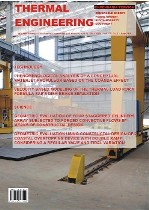EVALUATION OF STATIC PRESSURE BEHAVIOR IN AN OSCILLATING WATER COLUMN WAVE ENERGY CONVERTER
DOI:
https://doi.org/10.5380/reterm.v18i1.67045Keywords:
oscillating water column, piston methodology, axisymmetric domain, static pressure, harmonic movementAbstract
The international scenario of non-renewable resources scarcity coupled with increasing energy demand are incentives for the diversification of the world's energy matrix with a focus on renewable energy sources. Among these sources, energy from sea waves is especially attractive because its global resource is estimated around 2 TW, comparable to the average electrical power consumed worldwide each year. There are currently several technologies proposed for the sea wave energy conversion into electricity. Among them it stands out the Oscillating Water Column (OWC) converter, which basically consists of a hydropneumatic chamber and a turbine duct where a turbine is installed. Its chamber is opened below the sea water free surface while the turbine duct outlet is free to atmosphere. Inside the chamber the water free surface oscillating movement produced by the incident waves causes the air to flow through the turbine duct and to activate the turbine, so the OWC principle of operating can be approximated to a cylinder-piston system. Therefore, one of the methodologies used in the computational modeling to simulate the operating principle of this device is the Piston Methodology, which simplifies the problem analysis considering only the air flow through the OWC converter. Among the phenomena that occur within the OWC device, the static pressure behavior is arguably one of the most important because it is through it that it is possible to estimate the hydropneumatic power and the converter efficiency. Thus, the objective of this work is to evaluate the static pressure behavior within the OWC, using the Piston Methodology, by imposing a monochromatic wave boundary condition in an axisymmetric domain. Among the obtained results it was inferred that the static pressure, in this case, depends directly on the flow acceleration and it is strongly influenced by the vorticity generated in domains with a change of area.
Downloads
Published
How to Cite
Issue
Section
License
Direitos Autorais para artigos publicados nesta revista são do autor, com direitos de primeira publicação para a revista. Em virtude da aparecerem nesta revista de acesso público, os artigos são de uso gratuito, com atribuições próprias, em aplicações educacionais e não-comerciais.



